23Ancient inventions that prove the saying “Necessity is the mother of invention”

There is an old and famous proverb that “necessity is the mother of invention”, and to a large extent it is completely true, as many inventions came as attempts to solve daily problems, for example, or to facilitate life and difficult tasks, or even to reduce the costs and troubles of certain things.
However, the fact that necessity is the mother of invention does not mean that every invention resulting from need will be able to achieve great popularity and spread, as the matter depends greatly on marketing and whether it is practical or not, and even its general appearance and its compatibility with fashion sometimes.
Of course, many innovations and inventions throughout history went unnoticed and did not achieve any real spread, and here we will address some of the most interesting and some of the strangest ones, which perhaps it is not surprising that they remained ink on paper, or that they spread for a short time among a small group before they disappeared Forever.
Blizzard Masks

Canadian women wearing face coverings to protect themselves from snowstorms, 1939.
In the Arab region in general, the climate is often mild to hot, which makes snow a rare occurrence in most parts of the region, and snow storms are more rare, but for northern Europe, Canada and the northern part of the United States, the matter is very different, as there is a climate that tends to be very cold, and storms Snow is a regular and expected partial event in the winter, so the idea of a mask that prevents its harm and protects people from it will seem interesting and perhaps close to people's need.
What appears in the image above is a plastic mask with a conical shape that was supposed to protect from snow storms in the Canadian city of Montreal, but apart from these photos and a few other photos, the project has been an orphan since its birth and its transformation from a plan and idea into a real experimental tool.
The main factor that killed the idea was the very strange shape of these masks, as a thick scarf with a hat is a practical and more “fashionable” option than this mask.
floating car

US President Johnson driving his floating car in 1965.
During the 1960s, West Germany (the part of Germany that fell under Allied control) desperately wanted to move beyond the war and the great devastation it had left, so the period was an excellent time for start-ups and new products, and for some the idea of a new successful product was to combine the car and the boat to make an amphibious car after It turns out that making a flying car is far from realistic in relation to the technologies available at the time.
The car was really impractical, and fortifying it to make it waterproof and able to float was very expensive in a way that made it much more expensive than ordinary cars, and as a result, any desired benefit from owning it was opposed to its high price and impracticality.
In any case, the project managed to live for several years until the then US President (Lyndon Johnson) was acquiring one of these cars, and carrying out pranks on his guests using it.
Single wheel motorcycle

A Swiss engineer rides a unicycle on his way from France to Spain in 1931.
Everyone knows the bicycle, and the one-wheeled version of it that is often used in circuses by acrobats, but as for the motorcycle, the one-wheeled version has been extinct for a long time and was not for acrobatic purposes or to show off skills, but rather it was supposed to provide an alternative to transport, perhaps not an alternative Really practical but an alternative anyway.
The single-wheeled motorcycle relied on a rail within a large wheel, as the engine inside it powered the rail to turn the wheel and drive on the road.
The problem with this bike is that it was very unstable in terms of horizontal balance, and steering it was very difficult, as it required the driver to change his weight, which was very difficult, as any sudden or rapid change of direction would cause the bike to overturn.
As a result, this bike did not get any wide spread, and by the fifties it had, in fact, completely disappeared.
baby cages

A child is placed in a metal wire cage outside the porch of a building in New York City in 1937.
Before the spread of modern civilization and the transformation of cities into places crowded with cars, bicycles, etc., children were usually left with great freedom in the streets and outdoor spaces, as leaving the house was an important matter at the time.
But with the spread of tall buildings, diminishing green spaces from the cities, and the streets turning into a very dangerous place with cars and bikes everywhere; Cages made of metal wire hung outside windows were relatively common.
Suspending a child on wires several stories high in the air isn't a good idea, of course, but for the first half of the 20th century it seemed to make a lot of sense.
After several incidents involving children falling from high balconies, or cages falling as they were, the idea began to recede very quickly, and it turned out that keeping the child in the house, even all the time, is much better than trying to “ventilate” them by placing them outside the windows.
Luminous tires

A 1960s photo of a woman adjusting her pantyhose next to light-up tires made by Goodyear.
During the fifties, the well-known company Goodyear in the field of tire industry carried out a bold and strange experiment, which was placing small bulbs inside the tires made of one piece of partially transparent rubber. Quite an eye-catcher, and it would be even if it was reproduced today.
The fact that the tires were very eye catching did not help them last, they were very expensive and really impractical, and the way they were manufactured did not help at all about being less durable compared to the regular boring black tires.
Eventually, these tires were discontinued in the 1960s, and like many other popular things of the past, they were completely forgotten with time.
Metal hats and daggers

Soldier wearing a metal helmet and a dagger with hand protection designed for the British Army during World War I.
During the Second World War, there were many weapons used that are very similar to the weapons that exist today, such as planes, tanks, missiles, and machine guns, of course, but before that and in the First World War, things were very different, as the planes were still very new, and the primitive tanks that existed at the time were Limited to the cars that were invented at the time and were of course very far from resembling current tanks, this made the vast majority of battles take place between soldiers directly instead of relying on machines and tools.
Great reliance on individual soldiers meant the development of better weapons for them, and one of the British inventions to help the soldiers was a steel helmet that covered the head and eyes with very small slits for vision, in addition to a dagger attached tightly to what looked like an iron glove worn in the hand.
The idea was different, but that didn't mean it was really good, and the design was never widely used especially since it was literally "bringing a knife to a gunfight."
amphibious bike
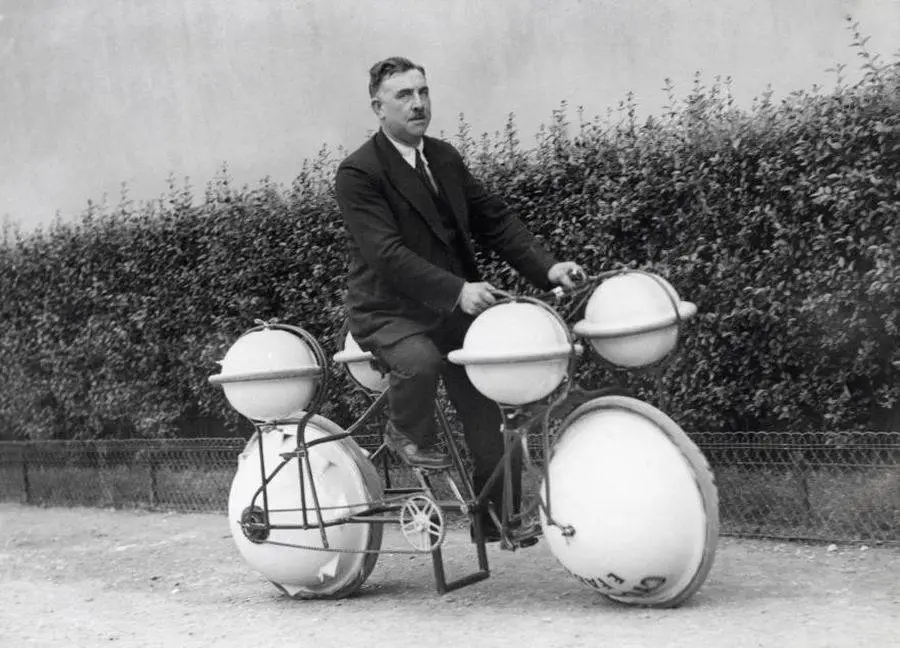
A bicycle capable of floating, but it did not achieve any success or spread after it was shown for the first time in Paris in 1932.
The idea of multi-field vehicles was not limited to cars that were attempted to be converted into amphibious and land-air, but there were similar attempts of this kind for bicycles as well, and perhaps one of the most unusual is the bicycle that was presented at the Paris Exhibition of 1932, which appeared for once Only then it completely disappeared without even trying to manufacture it.
This bike was very strange indeed. Instead of the usual skinny wheels; It used swollen semi-spherical wheels that made it very wide, and in addition to the spherical wheels, it included a number of balls attached to it to secure its buoyancy in the water and its balance there, knowing that it would immerse its driver in water up to his chest in the event of driving it, and perhaps this was the main reason for its survival as just a strange model and nothing more. turn it into a real product.
A piano for those bound to stay in bed

A piano designed for bedridden people in 1935.
The number of people who are forced to stay in bed due to illness, mobility problems, or other things is very small at any given time, and at the same time; The number of people who know how to play the piano and who care enough about it and have the financial means to buy it is also very small.
What about people who are forced to stay in bed and at the same time love the piano and play it well too? The number of these people is small enough to make the thought of producing a product marketed to this particular category not only strange, but rather stupid.
It is not known how many machines of this type were produced and how many were sold, but what is very clear is that a product with such a narrow range of potential users would never have been successful.
Car vinyl recorder

A portable phonograph in a Chrysler in 1956.
Before cassette tapes, optical discs, and even today's portable storage units and smartphones; Vinyl discs for the “phonograph” were the dominant method for music, especially in the first half of the twentieth century, and with the development of cars, merging music with them was inevitable, so portable car phonographs were introduced in the mid-1950s and spread very slowly. over a period of time over several years.
The problem with this machine was the very rapid wear of Vinyl discs as a result of vibrations resulting from the engine or movement on the road, and the amount of stored music was small compared to later music transfer media in the mid-sixties such as 8-Track and cassette tapes.
Now, after many years, vinyl discs have been used for music by some, but their presence in cars is a thing of the past and will remain so.
Gas-resistant strollers

A British woman wearing a gas mask pushes a chemical-resistant baby stroller in 1938.
The first use of chemical weapons (in their modern form at least) was in World War I, and in most cases the agent will be some kind of gas that either kills a person instantly or causes neurological or respiratory damage.
Of course, chemical weapons are not as destructive as nuclear weapons, but they have a similar quality that has contributed to the global ban on their use: they are uncontrollable over which they spread, and targeting almost anywhere with them can (and often does) turn on civilians.
Fear of chemical weapons after World War I grew increasingly, and with the escalation of political tension in Europe at the end of the thirties with the great expansion of Nazi ambitions; Chemical weapon fear spread (similar to the post-WWII wave of nuclear weapon fear) and gas masks, followed by the idea of gas-resistant strollers popped up in a few photos from the 1930s, but there are no records of their widespread use at any point in time. Perhaps because chemical weapons have seen a significant decline in use over time, and because they are an extremely impractical tool and are very heavy in weight.
Metal body armor

An American soldier wearing body armor during World War I, 1917-1918.
As I mentioned in a previous paragraph, the type and power of weapons during the First World War was very different from the present time and is considered to a large extent primitive by today's standards, and firearms (primarily guns) were not as powerful as today, but their projectiles often remained within the injured victim's body. And you can't penetrate it, which made the reuse of metal armor an appropriate idea perhaps in World War I, or the idea was appropriate enough for the Americans at least.
The intended shield covered the head and torso without the extremities and was made of an alloy of nickel, chromium and steel and weighed about 20 kilograms. movement and does not protect them from newer ammunition, as the age of this shield was confined to the year in which the United States fought in the First World War.
Curved barrel for guns

A man holds a rifle with a curved tube attached to it during World War II.
Firearms changed the look of individual battles dramatically, transforming what was previously solely dependent on skill and long-trained soldiers into a more mass-based battlefield, with any soldier being able to defeat any other soldier regardless of the difference in experience.
In addition, firearms have helped make battlefields more distanced, with no need for combatants to engage each other, but there is one thing they haven't changed: to be able to shoot someone you have to be in direct line of sight.
During the Second World War, the Nazis wanted to change the matter, especially since the First World War was a trench warfare, where the soldiers were stationed in their trenches so that they would not be exposed to enemy bullets, and they would be able to shoot him if he approached.
To solve the problem, the Nazis invented a curved metal tube added to the front of the gun so that it would be able to fire behind the corner or outside the trench without the need for any part of the soldier's body to appear. Of course, it required a weaker and less fast bullet to accept the curvature of the trajectory, and the result was a very weak, slow and completely inaccurate bullet, which ended the invention in its infancy.
TV glasses

Inventor (Hugo Greensback) shows off his "television glasses" for Life magazine.
What is the main problem with old (electronic cannon) TVs? In the first place: the very large size and the difficulty of moving it from one place to another, and of course the lack of privacy because anyone in the room with you can see what you are watching.
So in principle, an invention that solves the problem might be a good thing; Television glasses are this invention that is supposed to solve the matter, and it consists of two very small televisions placed within a frame of glasses so that they are worn directly on the eyes.
In terms of future thinking, there is no doubt that this invention was something special, as modern virtual reality glasses adopt it as a primary reference, but unlike virtual reality glasses and augmented reality glasses, this TV was not affected by the trend and did not offer anything new to the experience of watching television, and being released in 1963 It is very old and most likely came at the wrong time as it became extinct completely and quickly, but it left the idea at least, and this idea is what contributed to the virtual reality that has become the technology of the future today.
Aircraft positioning machines
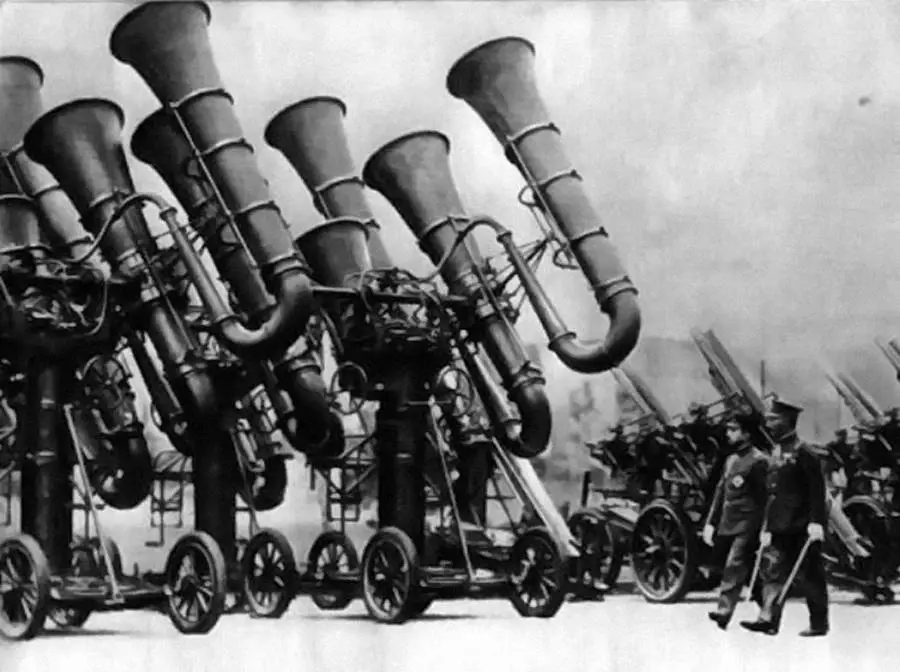
Japanese Emperor Hirohito inspects the pre-radar acoustic aircraft detection system during World War II.
Today, locating aircraft in the sky is relatively easy using radar systems that exist in almost all countries of the world within their military facilities and within civilian facilities such as airports, but radar is not a really old invention, as it was invented for the first time in 1935 in Britain and from there it spread slowly in other countries. Then it spread quickly with the leakage of its specifications and method of operation to other countries, but before the existence of radar, planes did not easily fly where they wanted without anyone knowing about them.
When flying at relatively low altitudes, the sound of the roar of aircraft (planes that used propellers in the past) can be heard, but very slightly and without the possibility of determining its source accurately, so the armies have found alternative ways to locate the aircraft more precisely, by using what looks like large horns directed at a very small inclination. From each other.
These horns were picking up and amplifying the sound of the engines, and by selecting the loudest “horn” the aircraft could be roughly located so that it could be defended against or anticipate its path and potential targets.
This technology was used extensively in Japan during World War II, but it soon disappeared completely with the advent of radar, which was much better in terms of accuracy and location speed as well.
Reading glasses in bed

A woman wearing mirrored reading glasses in Britain in 1936.
In the event that you, as in my case, prefer to read a little or watch a TV program or a movie to help you sleep, then you often fall into the problem that it requires sitting to do it, while your main goal, which is sleep, needs to lie down often, so in principle there is a way to read a book or Watching a screen while you fall asleep lying down is very desirable, and having glasses that use mirrors to that end would be highly desirable (at least at first glance).
The problem was, on the one hand, that the number of people who wanted to read while slowly falling asleep was relatively small, and even among them, the proportion of those who did not mind wearing reading glasses with mirrors and a very strange shape was even less, and the fact that the glasses would be most useful in the time before bed is not a good idea, so any Anyone who wears eyeglasses, for example, knows that sleeping with them on is never a good idea.
Skate motorcycle
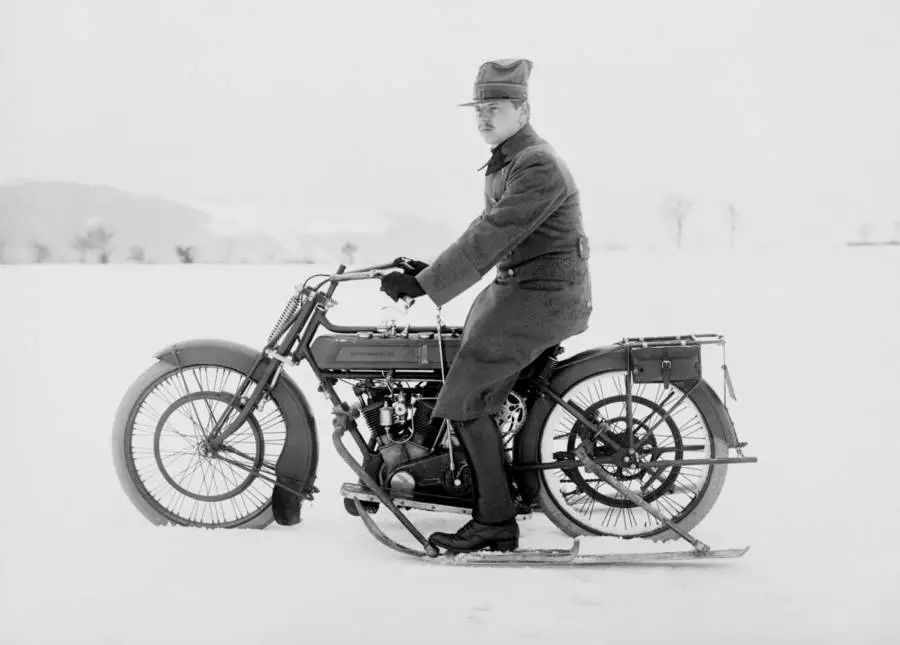
A man rides a motorbike with sleds around the Swiss town of Kersatz during the First World War.
In the event that you live in a cold area and suffer from the problem of frost and snow during the winter, of course you know that driving on snow is not a good idea at all, as the car or bike will suffer from difficulty in obtaining sufficient friction to walk, and most importantly, it will have difficulty moving with the snow accumulated in front of it, as it is It will cut through the snow quickly due to its greater weight versus the smaller wheel-to-floor contact area.
The bike shown in the above image is supposed to solve the problem of moving over snow, since the skis will increase the area of contact with the floor and allow them to “float” on the snow without getting stuck in it, but they will not be able to provide the necessary friction on the one hand and will not solve the most common problem with snow and frost: slip.
This design appeared in the first quarter of the twentieth century, but it soon disappeared completely and was forgotten to remain just another idea documented in a picture only.
Automated board
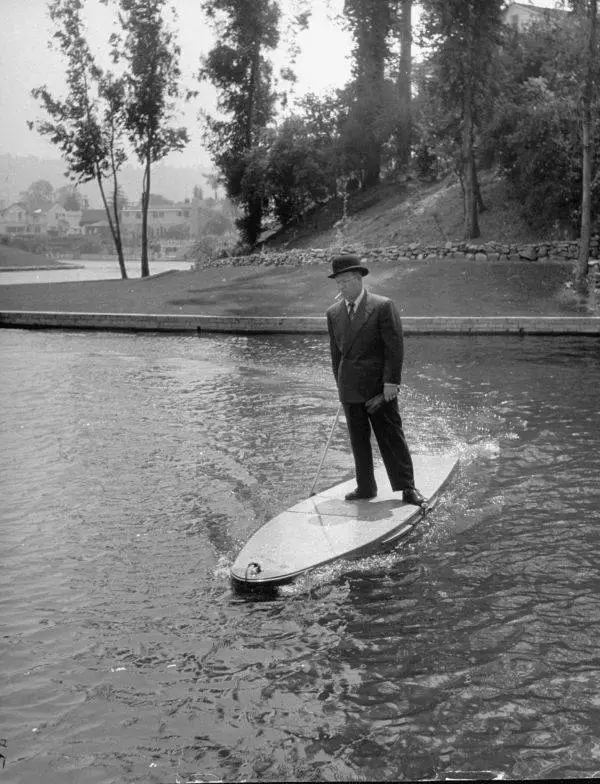
Inventor Joe Gilberg showing off his motorized surfboard, 1948.
What happens if you combine a surfboard with a small fishing boat? You will end up with a strange design for a device that seems completely impractical, although in terms of appearance it is very beautiful and even interesting.
Of course, this board did not achieve any spread, as it will not secure the water skiing of surfboards, and at the same time it will not secure the balance or even the speed of small fishing boats. Although it combined the two ideas together, it lacks the positives while increasing the negatives, and whatever you want to do A small wooden boat or surfboard (without a motor like that) would be more useful and practical for you.
Initial bike shoe design

A man shows off pedal shoes that function like bicycles, circa 1910.
Before the idea of shoes with small wheels for walking on flat surfaces appeared, and before the idea of boards for this matter came; Bicycles were the dominant thinking tool in terms of being a faster-than-walking mobility tool that did not use fuel, so when the idea of wheeled shoes began, it was clear that the design close to the shape of the bicycle was preferred, but of course for a short time.
The mechanism of action of this strange invention comes from the fact that the downward pressure separates the tires and gives rotational force to the rear wheel, and while the foot is pulled up to return the ball, the other foot presses the second pedal to advance the push.
The working principle of this machine seems enticing for a moment, but it is very impractical, and just imagining its use seems very funny, perhaps the good thing is that it helped give rise to the roller shoes and boards so popular today.
public “urinals”.
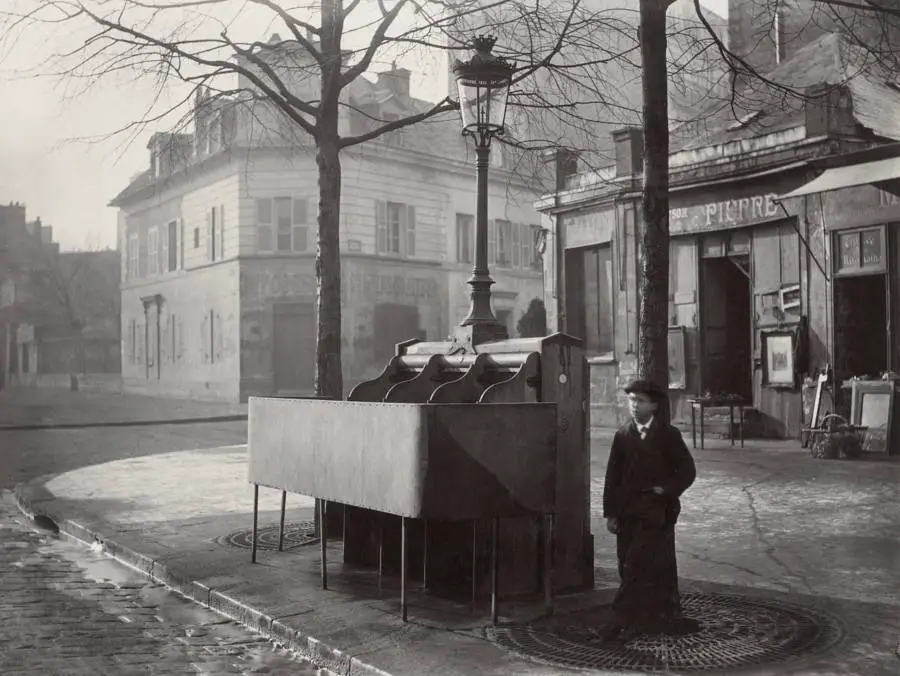
A child standing next to a "urinal" in a street in Paris in 1865.
Public toilets today are one of the important and widespread services in many cities and places, but the idea of their existence is not really new, as it appeared since the nineteenth century, especially in France, where “urinals” spread in the streets of Paris, bringing their number to about a thousand by 1865 distributed in different parts of the city.
These initial designs had clear design defects, as they lack privacy on the one hand, and allow wind and air to enter easily except that they do not even protect from rain, but their biggest problem is perhaps that they constitute a source of bad smells, and this is what led to their decrease with time and their complete disappearance, to be solved In their place are closed public toilets, but in much smaller numbers, of course.
Pedestrian protection nets

A car with a metal grille to reduce the risk of traffic accidents with pedestrians in 1924.
When cars began to spread at the beginning of the twentieth century, they were very slow, but very heavy, and with the fact that the roads were previously used by vehicles and pedestrians only, there were no sidewalks, and as a result, traffic accidents were many, and although the first cars were not with great speed, their design and materials made them So heavy that a shock from it even at a low speed could cause very great harm to the injured person.
One of the initial ideas as solutions was to install a network of metal wires on the front of the car, so that when a pedestrian hits, he will not fall under the car, but the network will carry him and mitigate the impact of the shock.
The problem was that the old cars were loud for a good reason: they often needed to travel on unpaved roads and even uneven terrain, which made the grid a huge hindrance to traffic on the one hand, and its “safety features” were not really convincing as accidents were serious even with use it.
The gun that takes pictures

38Caliber pistol with a small camera and some photos taken with it in 1938.
The one in the picture is not an ordinary pistol and of course it is not an ordinary camera. This is a revolver with a revolving reel that fires 0.38 caliber bullets and works as any other gun in terms of shooting, but in addition to shooting, it is equipped with a small camera that takes pictures when the trigger is pressed.
There are many cases in which a person would like to take pictures as preserving certain memories, or as a souvenir from people, or even an impressive view, but taking pictures with shooting is not one of the widespread areas, and of course it is not favored by many.
shower cap

German actress in a promotional photo of a head covering that protects hair and cosmetics when showering, 1970.
For most women with long hair, hair styling is not easy at all, and it often takes a lot of time and so does applying cosmetics (especially for those who like to wear a lot of them), so daily showering and frequently spoiling the hair is not a popular idea among women nowadays as hair coverings The bathroom has become very widespread, and as for cosmetics, the solution may be this strange hat that prevents soap and water from reaching the head.
With regard to not washing the hair, the matter is very normal, but in terms of cosmetics, the matter is different. Leaving it on the face for several days is not suitable for its shape on the one hand, and it is not desirable in terms of its effect on the skin and the annoying feeling it leaves, and taking this into account in addition to the strange shape of this cover, do not It is surprising that it did not find a real spread when it was released in the late seventies.
Flaming fumes

The inventor (George Stern) showing his invention: a liquid that quickly evaporates so that it can be ignited on the hand without causing burns in 1938.
At the end of the thirties of the twentieth century, the American inventor George Stern presented a new invention, which is a flammable liquid that quickly evaporates, so that placing it on the hand and igniting it will give a volatile flame that does not harm the user’s hand in the first place, because the liquid evaporates a little faster than the speed of ignition.
It was very popular as a nominal invention at first being really special, but commercially things were very different.
Attempts to find real uses for this burning liquid did not give any result, and it was later found that it does not have any practical applications in reality, and as a result its inventor himself admitted that this liquid is really useful only in magic tricks and perhaps for creating horror movie effects.
Source:websites

